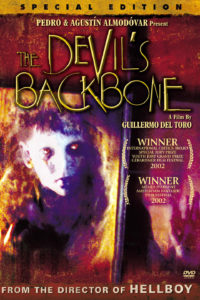The Devil’s Backbone–Peter Pan meets “The Shape of Water”

The Devil’s Backbone (2001) (Spanish: El espinazo del diablo), directed and co-written by Guillermo del Toro, was independently produced by Pedro Almodóvar and foreshadows his Academy Award winning “The Shape of Water” (see my March 19, 2018 review).
Set in 1939 during the final year of the Spanish Civil War, we see in the opening scene an orphanage in the middle of a solitary dessert. A deactivated bomb is standing in the courtyard.
An unexpecting twelve- year-old, Carlos, is left by his guardian and almost immediately bullied by two other orphan boys. On a dare to sneak to the kitchen for water, Carlos hears a chilling whisper from an unknown ghost, Santi, appearing as a boy about the same age.
This is a mythic tale of love and revenge, greed, the loss of family, mixed with a potent dose of magical realism del Toro conveys in all of his films (including his masterpiece, “Pan’s Labyrinth”.) Carlos, who fearlessly wants to know the truth, and Santi, whose demise is shrouded in mystery, eventually make a pact. As the war begins closing in on the orphanage, violence and desperation erupt and Santi’s prediction comes true. The abandoned boys must band together if they hope to survive.
Dr. Caseres shows Carlos how the orphanage raises funds: by selling a spiced fluid preserved from deformed aborted or stillborn fetuses that “remedies” many ailments including impotence. The exposed fetuses in fluid are “the devil’s backbone”, an elixir with miraculous power. A visual metaphor illustrating how war entraps, just like insects in amber and fetuses in jars, The Devil’s Backbone exposes the horrors of war and fascism through the lens of fantasy.
This film, after a sagging middle with slow camera movements leading nowhere but to the orphanage basement, eventually evolves into an extraordinary dramatic narrative of tension and dread. It is a coming-of-age story combined with a tale of enormous deception resulting from misjudging human character.
Fantastic cinematography, –some sepia-toned scenes evoking the lighting of a Velasquez painting,– is well-worth viewing on its own merits. The opening underwater sequences will remind the viewer of del Toro’s later cinematic undertaking, “The Shape of Water”. The mark of del Toro is everywhere in evidence. Watching The Devil’s Backbone now within the context of having seen “The Shape of Water” allows a glimpse into the imagination of a very original filmmaker!

celeste
I adore Del Toro and his monsters.